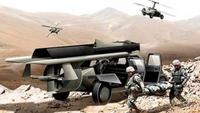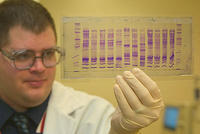-
A flying car is developed for the U.S. military

Flying cars would enhance the mobility of soldiers. Transportation will no longer be restricted to trafficable terrain that makes movement predictable and easy to track, and a flying car will enhance capabilities for resupply operations, fire-team insertion and extraction, and medical evacuation — reducing timelines and increasing the probability of survival.
-
-
Collaboration with industry leads to improved forensics
Three-dimensional (3D) scanners used at crime scenes for forensic investigations are not just the stuff of prime time television. Investigators and crime laboratories are using 3D laser scanning measurement systems to measure and model, in 3D simulations, the critical aspects of crime scenes. A 2009 National Academy of Sciences (NAS) report, however, questioned the reliability of some forensic sciences, including the use of 3D scanning technique. Furthermore, pressure began building in the forensics community to have crime laboratories and stand-alone crime scene units in the United States adhere to specific standards in their services, which require traceability to the SI [the SI in SI traceability refers to the International System of Units (Système International d’unités)].
-
-
As many as 1,400 killed in a suspected chemical attack in Syria (updated)
Rebel sources say the number of dead in a Syrian army chemical weapons attack, which targeted a dozen villages in a rebel-held area east of Damascus, has reached 1,400. The Syrian government admitted launching a major military offensive against rebels in the area – both rebels and government sources say it is the largest military operation since the beginning of the war — but strongly rejected the allegations about chemical weapons use by the Syrian army. The Israeli defense minister, in the first official Israeli reaction, confirms the Syrian military used chemical weapons. Chemical weapons experts say there are two other possibilities: the Syrian regime may have used crowd-dispersal chemicals in higher-than-usual concentration, causing death among people trapped in bunkers and shelters; or the army may have used fuel-air bombs in bombing Sunny residential areas. Such bombs, also called thermobaric explosives, rely on oxygen from the surrounding air, unlike most conventional explosives which consist of a fuel-oxidizer premix.
-
-
Iris recognition useable as a long-term form of identification
For decades, researchers seeking biometric identifiers other than fingerprints believed that irises were a strong biometric because their one-of-a-kind texture meets the stability and uniqueness requirements for biometrics. Recent research, for example, has questioned that belief, finding that the recognition of the subjects’ irises became increasingly difficult, consistent with an aging effect. Other researchers, however, found no evidence of a widespread aging effect. A computer model used to study large populations estimates that iris recognition of average people will typically be useable for decades after the initial enrollment.
-
-
Secure, private Internet and cloud to soldiers, marines at the tactical edge
Squads of soldiers or marines on patrol in remote forward locations often do not have the luxury of quickly sharing current intelligence information and imagery on their mobile devices, because they cannot access a central server. Troops frequently have to wait until they are back at camp to download the latest updates. In the meantime, mission opportunities may erode because the information needed at the tactical edge isn’t immediately available. DARPA’s Content-Based Mobile Edge Networking (CBMEN) program aims to provide an alternative approach to the top down focus of most military networks by starting the content sharing at the individual soldier or marine level.
-
-
Conflicting readings of possible chemical weapons use in Syria
Rebel sources say the number of dead in a Syrian army chemical weapons attack, which targeted a dozen villages in a rebel-held area east of Damascus, is between 750 and 1,300. They say it is not possible to offer precise numbers because some areas are not yet accessible. The Syrian government strongly rejected the allegations about chemical weapons use by the Syrian army. The Israeli defense minister, in the first official Israeli reaction, confirms the Syrian military used chemical weapons. Chemical weapons experts say there are two other possibilities: the Syrian regime may have used crowd-dispersal chemicals in higher-than-usual concentration, causing death among people trapped in bunkers and shelters; or the army may have used fuel-air bombs in bombing Sunny residential areas. Such bombs, also called thermobaric explosives, rely on oxygen from the surrounding air, unlike most conventional explosives which consist of a fuel-oxidizer premix.
-
-
Reports: hundreds killed in chemical weapons attack east of Damascus
Syrian rebels say at least 750 people were killed in attacks on villages in rebel-held areas in the Ghouta region east of Damascus. News agencies quote medical personnel who confirmed that hundreds of victims treated in hospitals and make-shift first-aid stations were suffering from symptoms associated with chemical weapons attack. Syrian government officials deny that regime forces used chemical weapons. The Arab League called for immediate investigation, and the U.K. said it would bring the reports to the UN Security Council today.
-
-
Rapid response, imaging of injuries aided Boston Marathon bombing victims
According to the Centers for Disease Control and Prevention (CDC), bombing survivors have the highest incidence of injury to soft tissue and musculoskeletal systems with the most extreme injury being traumatic amputation, which is reported in up to 3 percent of cases. The Boston Marathon bombings resulted in three fatalities and 264 casualties, with the most severe injuries involving lower extremities of those located closest to the blasts. Blast injuries within civilian populations are rare in the United States, so when they do occur they challenge the medical community rapidly to respond to concurrent evaluation and treatment of many victims.
-
-
Suburban Chicago police cancels anti-terrorism training course after complaints
The police at the city of Lombard, Illinois, has cancelled a class on counterterrorism after the Chicago branch of a Muslim advocacy group complained that the Florida-based instructor and his teachings were blatantly anti-Muslim. The instructor has faced similar criticism in Florida. The course was to be taught through the North East Multi-Regional Training group, which trains Illinois police and corrections employees. The Illinois Law Enforcement Training and Standards Board said it was reviewing the course – titled “Islamic Awareness as a Counter-Terrorist Strategy” – and the materials used in it. The board said that instructor’s qualifications will also be reviewed.
-
-
Mathematical model informs gun policy debate
The relationship between the legal availability of guns and the firearm-related homicide rate has been a hot topic of debate in the United States for more than three decades now. Gun-control advocates argue that unrestricted gun availability promotes the occurrence of firearm-induced homicides. Gun-rights supporters have pointed out that gun possession can protect potential victims when attacked. A new paper presents a mathematical model – admittedly, with limited data – which offers a logical, detached approach to the gun-control debate.
-
-
Islamic group’s plan for a 9/11 "Million Muslim March" on Washington denounced
The American Muslim Political Action Committee (AMPAC) is organizing what it hopes would be a mass demonstration by American Muslims on 11 September in Washington, D.C. Critics called the demonstration ill-timed, if not downright offensive. Mainstream Muslim American groups describe group members as virulently anti-Semitic “truthers” who question al Qaeda’s responsibility for the 9/11 attacks. There is little chance a million people would show up for the march: AMPAC, based in Kansas City, Missouri, has just 57 supporters signed up for the 11 September event on Facebook.
-
-
Forensic familial DNA searches carry risk of certain false matches

DNA-based familial search may misidentify distant relatives of known offenders as close relatives. Familial searches can reliably distinguish first-degree relatives from unrelated individuals, but may misidentify distant relatives as being immediate family, according to this new research.
-
-
Gen. Dempsey: U.S. military options against Iran “better” than last year
General Martin Dempsey, the chairman of the Joint Chiefs of Staff who is on an official visit to Israel and Jordan this week, said that in his meeting with Israeli leaders he told them that “since I was here last year [October 2012], [the United States has] better military options than we did a year ago” to deal with Iran’s nuclear weapons program. “That’s because we’ve continued to refine them,” he said. “We’ve continued to develop technology, we’ve continued to train and plan.”
-
-
New camouflage makeup shields soldiers, firefighters from heat of bomb blasts, fire
Camouflage face makeup for warfare is undergoing one of the most fundamental changes in thousands of years, as scientists today described a new face paint that both hides soldiers from the enemy and shields their faces from the searing heat of bomb blasts. Firefighters also could benefit from the new heat-resistant makeup.
-
-
Lawmakers, scientists question FBI’s investigation, conclusion in 2001 anthrax attacks

Twelve years after the fall 2001 anthrax attacks, and six years after the 2007 FBI’s determination that Bruce Ivins, a top government anthrax researcher at the U.S. Army Medical Research Institute of Infectious Diseases (USAMRIID), was the perpetrator of the attacks (Ivins died in 2008 of apparent suicide), lawmakers and USAMRIID scientists insist that the FBI’s conclusions are not supported by scientific evidence – indeed, that some basic scientific facts make the Bureau’s conclusions untenable.
-
More headlines
The long view
Tantalizing Method to Study Cyberdeterrence
Tantalus is unlike most war games because it is experimental instead of experiential — the immersive game differs by overlapping scientific rigor and quantitative assessment methods with the experimental sciences, and experimental war gaming provides insightful data for real-world cyberattacks.
Using Drone Swarms to Fight Forest Fires
Forest fires are becoming increasingly catastrophic across the world, accelerated by climate change. Researchers are using multiple swarms of drones to tackle natural disasters like forest fires.
Testing Cutting-Edge Counter-Drone Technology
Drones have many positive applications, bad actors can use them for nefarious purposes. Two recent field demonstrations brought government, academia, and industry together to evaluate innovative counter-unmanned aircraft systems.
European Arms Imports Nearly Double, U.S. and French Exports Rise, and Russian Exports Fall Sharply
States in Europe almost doubled their imports of major arms (+94 per cent) between 2014–18 and 2019–23. The United States increased its arms exports by 17 per cent between 2014–18 and 2019–23, while Russia’s arms exports halved. Russia was for the first time the third largest arms exporter, falling just behind France.
How Climate Change Will Affect Conflict and U.S. Military Operations
“People talk about climate change as a threat multiplier,” said Karen Sudkamp, an associate director of the Infrastructure, Immigration, and Security Operations Program within the RAND Homeland Security Research Division. “But at what point do we need to start talking about the threat multiplier actually becoming a significant threat all its own?”
The Tech Apocalypse Panic is Driven by AI Boosters, Military Tacticians, and Movies
From popular films like a War Games or The Terminator to a U.S. State Department-commissioned report on the security risk of weaponized AI, there has been a tremendous amount of hand wringing and nervousness about how so-called artificial intelligence might end up destroying the world. There is one easy way to avoid a lot of this and prevent a self-inflicted doomsday: don’t give computers the capability to launch devastating weapons.
